|
Only have a minute? Listen instead
Getting your Trinity Audio player ready...
|
The federal government’s two-and-a-half year long lawsuit against the builders of a private border wall south of Mission came to an end Tuesday morning when prosecutors filed a stipulation for dismissal in federal court.
And with the dismissal, details of the settlement agreement between the U.S. International Boundary and Water Commission and Tommy Fisher, the North Dakotan construction tycoon who built the 3-mile wall, were finally released to the public.
“The United States section of the International Boundary and Water Commission is pleased that the litigation has been settled,” IBWC Secretary Sally Spener said when reached via phone Tuesday afternoon.
“The settlement addresses the concerns that were identified by the USIBWC,” she said.
The Justice Department, on behalf of the IBWC, sued Fisher and his companies in December 2019. The suit alleged that the wall — which was not then built — could potentially put the United States in violation of a 1970 international boundary treaty with Mexico.
Indeed, just weeks after construction was completed, scientists with the IBWC determined that a portion of the structure did violate the treaty because it would deflect too much water in the event of a flood. In April 2020 those scientists issued a letter detailing that and other concerns they had regarding the structure.
But throughout the protracted pendency of the litigation, government prosecutors repeatedly indicated their intent to reach a so-called “settlement posture” with Fisher by seeking out alterations that would effectively mitigate the IBWC’s treaty concerns.
For his part, Fisher said he was pleased that the litigation had come to an amicable resolution.
“Both sides worked hard to reach a (settlement), you know, and I’m happy that it’s done and we can continue on and go from there,” Fisher said.

SECRET REPORT
However, the findings of an IBWC-commissioned engineering report that the two sides relied upon in reaching the settlement will continue to remain hidden from public view.
That’s due to the government’s claims that the report contains proprietary information not subject to disclosure under open records law, and which the commission will fight to keep hidden.
“The USA/USIBWC believes that the work and report of Arcadis contains proprietary information which pursuant to federal regulation is not subject to public disclosure, and to which the USA/IBWC will assert objections to its production,” reads the settlement agreement, in part.
The government is so concerned about maintaining the secrecy of the report, that the settlement agreement specifically stipulates Fisher and his attorneys must “return or destroy all physical (and electronic) copies” of the report.
The report was produced by the global engineering firm, Arcadis, which the government in 2021 contracted to study the fence — from its galvanized steel bollards, to its concrete foundation, to its impact on the Rio Grande’s riverbank.
“(T)he ARCADIS report was prepared for the litigation and as such is considered a privileged litigation work product,” Spener clarified via email.

(Dina Arévalo | [email protected])
SETTLEMENT TERMS
Though the contents of the engineering report will remain unknown, the settlement agreement itself reveals several startling details regarding the IBWC’s expectations of the structure and its future.
Namely, the commission fully expects erosion — which began just weeks after construction ended in 2020 — to continue at the site.
As such, many of the terms of the settlement involve mitigating the effects of existing and future erosion.
“In areas where erosion becomes a continuing and repeated problem such that permanent grass establishment is not effective to prevent erosion, TGR shall install rip rap or more permanent ground cover to prevent soil erosion,” reads the settlement agreement.
TGR refers to TGR Construction, the company founded by Tommy Fisher and which he used to build the wall.
The settlement also includes repair provisions for erosion caused by “wave action” from water flowing downstream, as well as any undercutting of the soil beneath the wall’s T-shaped concrete foundation — effects that have already been seen at the site.
The agreement also makes clear that the IBWC remains concerned over conclusions it published in April 2020 that the structure — which follows a sharp U-shaped bend in the river — will significantly alter the flow of the Rio Grande in the event of a Hurricane Beulah-like flood.
The commission uses the 1967 storm as a benchmark for determining if development within the Rio Grande floodplain will violate the 1970 international boundary treaty.
Using that benchmark, IBWC hydrologists determined that one point of the structure would cause a deflection during a Beulah-like flood approximately twice the amount of the tolerances allowed by the treaty.
The solution agreed upon by both sides stipulates that TGR Construction will open a singular gate located about midway along the wall’s span — a gate originally installed to allow for agricultural access to a pump station.
The agreement also requires the removal of 10 bollards if the potential for a flood is deemed serious enough. And TGR must obtain a $3 million surety bond and maintain it for 15 years in order to cover the costs of any repairs.
Doing that, both sides agree, will sufficiently allow floodwaters to continue to flow unobstructed.
For Spener, the IBWC secretary, the settlement terms are sufficient to safeguard the country’s compliance with the treaty.
“The settlement agreement has addressed the concerns so that they (Fisher and TGR) will take actions so that we’re able to meet our obligations under the treaty,” she said.




